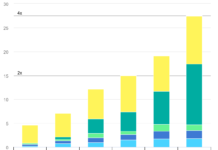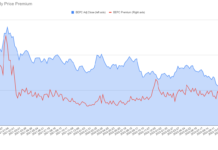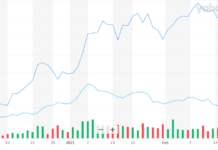Tom Konrad CFA
Highlights from a report on Clean Energy investments from the Pew Charitable Trusts.
The Pew Charitable Trusts just released their report on Clean Energy, finance, and investment in the Group of Twenty (G20) economies in 2010 [pdf].
I had the opportunity to review a pre-release version of the report. Some 2010 trends they discovered were encouraging or exciting, some were disappointing. I also had the chance to speak to the director of Pew’s Clean energy Program, Phyllis Cuttino, about the report. Here are the highlights from the report and our discussion.
Clean Energy Sectors
-
Total Clean Energy investment in 2010 was $243 billion.
-
Up 30% over 2009
-
-
Solar Photovoltaic (PV) installations grew 53% over 2009
-
17 GW of solar was installed in 2010
-
Distributed solar (defined as installations smaller than 1 MW) doubled to $56 billion, accounting for 26% of MW installed
-
PV hit grid parity in southern Italy due to high electricity prices and good insolation.
-
-
Wind grew 34%
-
40 GW added in 2010
-
-
Biofuels slumped
-
Lowest investment since 2005
-
Some markets are oversupplied with conventional biofuels
-
Next generation biofuels are not ready
-
-
Solar thermal was not tracked by the report.
-
Concentration Solar Power (CSP) and direct use solar thermal (for water, space, and process heating) were not included
-
I mention this because these are much more significant sectors than marine power, which was included in the report, and given the Pew center’s goal of providing information to policymakers to help them make better informed decisions, I’m hoping they will take the hint and include these important sectors in their next report update.
-
-
Energy Efficiency and Transportation spending did get some mention in the report, but the numbers were incomplete
-
Energy efficiency is hard to track because it’s difficult to determine what is efficiency spending, and what would have been done in the normal course of business.
-
The report only covered Transportation stimulus spending, not private sector investment.
-
-
Geothermal Power was also not tracked. Again, I hope they correct this oversight in next year’s report. What is not measured is often ignored.
Country Rankings
-
China took the lead in clean energy investment in 2010, displacing Germany.
-
China led in public financing (stock market) of clean energy companies.
-
Accounted for 50% of all manufacturing of solar modules and wind turbines.
-
-
Germany retained second place, mostly due to strong performance in installations of distributed solar.
-
The United States fell to third in total investment.
-
Investment in wind power dropped 50% from 2009 levels
-
Retains lead in venture capital and private equity investment, accounting for 73% of the G20 total
-
Accounted for 2/3 of all identifiable investment in Energy Efficiency, but this number is not particularly meaningful due to the difficulty of tracking energy efficiency spending. According to Cuttino, this is probably in large part due to the US playing catch-up. I think it is also due to the differences in how energy efficiency is implemented around the world, with the US putting more emphasis on incentives while other countries rely on regulation and higher energy prices to drive investment. The US model results in a higher level of identifiable investment, but has been less effective at driving overall efficiency.
-
-
Italy was in fourth place, because of a large rise in distributed solar projects
-
I expect PV growth in Italy should be expected to remain robust because they have hit grid parity, as mentioned above
-
-
Japan was much farther down the list in 11th place, almost entirely based on PV installations. As the Japanese understandably question their dependence on nuclear, they will want to accelerate their adoption of clean energy, in order to produce as much domestic energy as possible without the risks of nuclear power.
-
Over the last 5 years, clean energy capacity in Japan has grown at a 45% annual compound rate.
-
Small distributed installations grew at a 69% annual rate.
-
A 25% annual growth rate in investment was all that was needed to achieve 45% annual capacity growth because of falling prices.
-
Solar PV dominated Japanese clean energy investment in 2010.
-
Cuttino was not able tell me why she thinks that is. This is an important question because if clean energy is to replace the lost nuclear generating capacity in Japan, wind will need to play an important role. If past investment in wind has been small because of NIMBYism, then this opposition may be more likely to relax because of the recent demonstration of how nuclear power can be much worse. If the low historical investment in wind is mostly due to a lack of wind potential, wind will have a harder time contributing to Japan’s clean energy supply.
-
-
Japan has ambitious targets to source 28 GW of solar and 5 GW from wind by 2020. I expect them to adopt even more ambitious targets as a result of the nuclear crisis.
-
With 3.5GW of installed solar, it would take 3 years for Japanese solar installations to grow enough to produce as much energy as the 2.8 GW of damaged nuclear reactors at Fukushima Daiichi at current growth rates, even after assuming an 18% capacity factor for solar.
-
If all clean energy continues to grow at the current 45% compound rate, Japan will add 11.7 GW of capacity in 2011. Much of this will likely be biomass and wind, so the average capacity factor will be considerably higher than for clean energy just from solar, meaning that this new clean energy generation should be enough to replace the electricity from damaged reactors more than twice over in just one year. Those who think clean energy cannot replace nuclear power should reconsider.
-
What I Hope For in the 2011 Report
-
Tracking Solar Thermal and Geothermal investment.
-
More complete tracking of investment in alternative and efficient transportation
-
Some measure of the effectiveness of clean energy investment
-
A better methodology for tracking energy efficiency, perhaps by tracking how quickly a country’s energy intensity falls.
I also asked if they were looking into what makes an effective clean energy policy in more detail, and Cuttino told me they are working on a report on the non-financial barriers to clean energy investment. I’m very much looking forward to that.
Less
ons Learned
-
Feed-in Tariffs are one of the most effective methods of both encouraging Clean Energy installations and developing a clean energy industry.
-
If a country wants to develop clean energy manufacturing, it should first develop a domestic market.
-
Germany, China, and India have all successfully followed this model.
-
The United States is failing badly largely because of inconsistent government support for clean energy.
-
Research and development follow manufacturing. There has been an increasing stream of clean energy engineers migrating to the opportunities in China.
-
Transportation investment has largely been ignored in the past, but Cuttino believes that the current administration understands the importance of this critical sector.
-
Cuttino had recently attended CERA Week, and told me that even oil executives who would not utter the phrase “Peak Oil” were calling for increased vehicle efficiency and incentives to reduce oil consumption. John Hess of Hess Corp. (HES) was calling for a $1 per gallon gas tax and a $10 per ton carbon tax.
-
Clear and consistent policy support for clean energy have long been lacking in the United States. Until we make a firm commitment to the energy of the future, we will continue to be trapped by our addition to the energy of the past. Our dynamic Venture Capital helps incubate world-beating technology, which US companies would have the opportunity to commercialize, building new, world-beating industries if they had a reliable domestic market to sell into. As it is, the United States is simply the source of the great ideas behind the products that the rest of the world will be selling to us for decades to come.
This article was first published on Tom Konrad’s Green Stocks blog.
DISCLAIMER: Past performance is not a guarantee or a reliable indicator of future results. This article contains the current opinions of the author and such opinions are subject to change without notice. This article has been distributed for informational purposes only. Forecasts, estimates, and certain information contained herein should not be considered as investment advice or a recommendation of any particular security, strategy or investment product. Information contained herein has been obtained from sources believed to be reliable, but not guaranteed.








